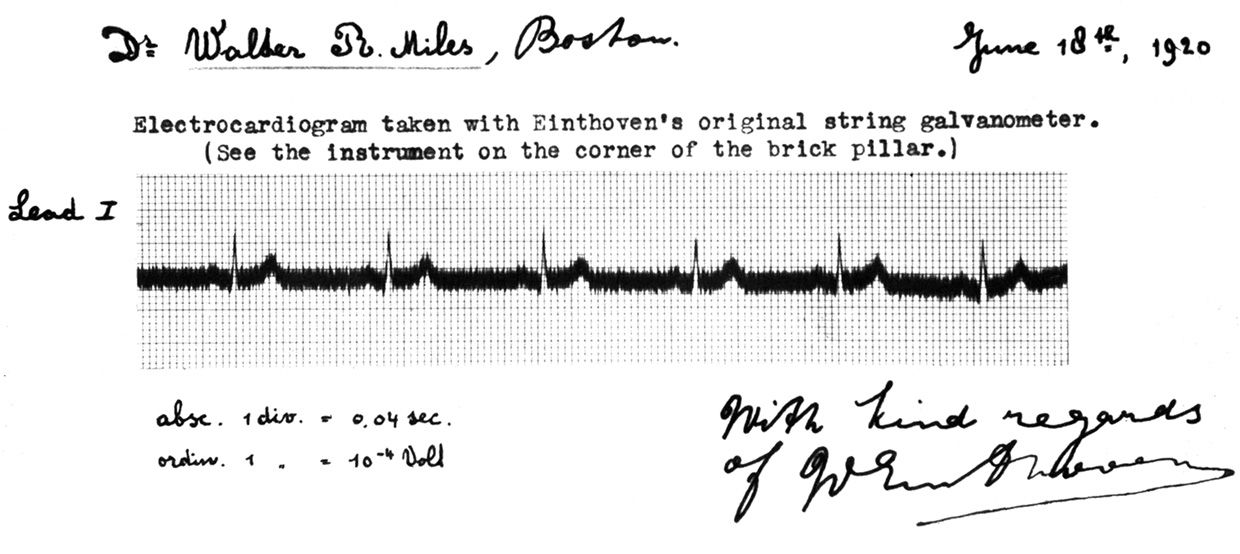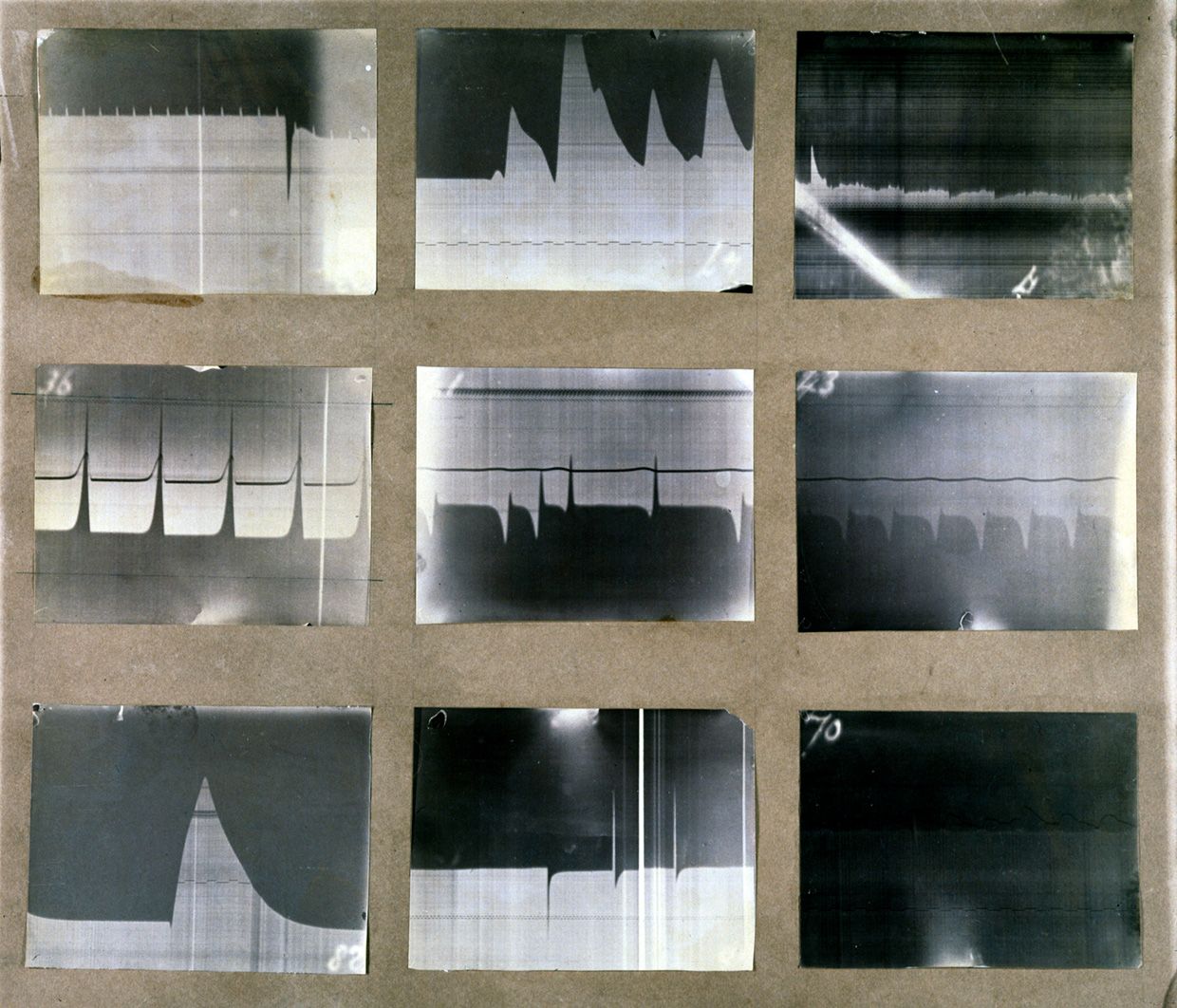Forget Electrodes, the First EKG Machine Used Buckets of Saline Solution and Telephone Wire
 Photo: Science History Images/Alamy Willem Einthoven, a physiology professor at Leiden University, in the Netherlands, and his string galvanometer, which was used for the first clinical recording of the heart's electrical pulses.
Photo: Science History Images/Alamy Willem Einthoven, a physiology professor at Leiden University, in the Netherlands, and his string galvanometer, which was used for the first clinical recording of the heart's electrical pulses. THE INSTITUTE For more than 100 years, doctors have relied on electrocardiography to measure the heart's electrical activity. The technique has its origins in the work of Willem Einthoven, who in 1905 used a string galvanometer to conduct the first recording of a human electrocardiogram (EKG). The string galvanometer, which consists of a metal fiber stretched between two magnets, was originally developed by French engineer Clement Adair in 1872 to send telegrams.
Einthoven's EKG work has now been commemorated with an IEEE Milestone. The IEEE Benelux (Belgium) Section sponsored the nomination. Administered by the IEEE History Center and supported by donors, the Milestone program recognizes outstanding technical developments around the world.
The string galvanometer offered the opportunity to record the human electrocardiogram in detail," says IEEE Life Senior Member Wim van Etten, the section's Milestone coordinator. In this way the medical world received an important diagnostic tool to discover certain heart diseases."
Due to the coronavirus pandemic, the Milestone dedication ceremony is still being planned.

 Image: Science History; Photo: SSPL/GettyImages
Image: Science History; Photo: SSPL/GettyImages Electrocardiogram recorded using Einthoven's string galvanometer [top].
Electrocardiogram recorded using British physiologist Augustus Desire Waller's EKG machine [bottom].
THE ROAD TO THE EKGScientists began the journey to modern electrocardiography in 1873 thanks to the capillary electrometer-which was invented by Gabriel Lippmann to detect electric current. The machine consisted of metal wires and a tube with one thick end and one thin end that was filled with mercury and sulfuric acid. The tube's thin end acted as a capillary-a narrow tube that allowed liquids to flow easily in opposition to gravity. When a pulse of electricity was sent through the machine, there were small changes in surface tension between the mercury and sulfuric acid, according to an article about the technology on the National Museum of American History website.
Using the electrometer, British physiologist Augustus Desire Waller developed the first EKG machine in 1887. It consisted of a capillary electrometer that was affixed to a projector. Electrodes were placed on the patient's chest and back; when electrical current entered the tube, the mercury leapt up a short distance. The movement of the mercury, which represented the heart's electrical pulses, was projected onto a photographic plate, a flat sheet of metal on which an image was recorded.
Although Waller was able to record the patient's heartbeat and the heart's electric pulses, the device was not accurate or precise, and it was slow in recording the pulses. Waller also did not recognize the clinical importance of the device and technique, according to A.D. Waller and the Electrocardiogram, 1887," a 1987 article in The BMJ.
Einthoven, a physiology professor at Leiden University, in the Netherlands, began to analyze Waller's data in 1901. He found errors in the visual recordings, according to a 2003 article in the Cardiac Electrophysiology Review. Einthoven wasn't a physicist, however, and he had trouble finding a mathematical solution that would correct the errors. According to an entry in the Engineering and Technology History Wiki, he sought the help of Hendrik Lorentz, a physics professor at Leiden who won the 1902 Nobel Prize in his field. The duo was able to solve the equations and correct Waller's measurements.
Einthoven wanted to develop a better device that could be used in clinical medicine. After three years of research and building prototypes, he introduced the string galvanometer in 1904 to the field of electrocardiography.
MAGNETIC ATTRACTIONEinthoven's galvanometer used a thin silver-plated quartz fiber to measure electrical signals. When the fiber carries current, putting it in a magnetic field causes it to be displaced because of the force of the magnetic field on the current, according to Einthoven's String Galvanometer," a 2008 paper in the Texas Heart Institute Journal. The fiber's movement was magnified and projected on a running film sheet, which recorded the signal. The device measured the electrical signals more precisely, more accurately, and quicker than Waller's machine, due to the movement of the quartz fiber.
In 1905 Einthoven partnered with the Leiden University Medical Center to conduct clinical trials.
At around 272 kilograms, the machine was too heavy to be transported from Einthoven's laboratory to the medical center. Instead, hospitalized patients were connected to the string galvanometer using a telephone wire that ran from the hospital to the laboratory, a distance of about 1.5 kilometers.
At the hospital, patients placed both arms in one bucket of saline solution and their left leg in a separate solution-filled bucket. The filled buckets acted as electrodes to conduct the current from the skin's surface to the string galvanometer, according to the 2018 book Interpreting ECGs: A Practical Approach.
The clinical recordings enabled Einthoven to characterize the shape of electrocardiograms as a number of successive waves," van Etten says. Einthoven also identified and coined the terms for P,Q,R,S,T, and U waves, which are components of the basic pattern of electrical activity on an EKG. The waves represent when the heart muscles contract and relax. The names are still in use, van Etten notes.
Einthoven wanted other physicians to be able to use his machine, but because of its size, he had a tough time finding a company that would manufacture it, according to the Engineering and Technology History Wiki.
After several rejections, Einthoven simplified the design. He worked with Cambridge Scientific, in Watertown, Mass. The company mounted the machine on a table, making it easier to install in hospitals. The machine went on the market in 1905.
The EKG machine was first used in medical diagnosis in 1908, and it remains an integral part of diagnosing and monitoring heart disease.
For Einthoven's invention and his work in electrocardiography-a term he also coined-he received the 1924 Nobel Prize in physiology or medicine.
The string galvanometer has led countless investigators to study the functions and diseases of the heart muscle," the Nobel website says.
The Milestone plaque is to be displayed at the Leiden University Medical Center, where the first clinical recording was taken. The plaque reads:
On 22 March 1905, the first successful clinical recording of a human electrocardiogram took place at this location, which at the time was the Academic Hospital Leiden. Willem Einthoven's pioneering work, from 1901 to 1905, resulted in a string galvanometer specifically designed to measure and record the heart's electrical activity, which made this medical achievement possible. This invention marked the beginning of electrocardiography as a major clinical diagnostic tool.
This article was written with assistance from the IEEE History Center, which is funded by donations to the IEEE Foundation.
IEEE membership offers a wide range of benefits and opportunities for those who share a common interest in technology. If you are not already a member, consider joining IEEE and becoming part of a worldwide network of more than 400,000 students and professionals.